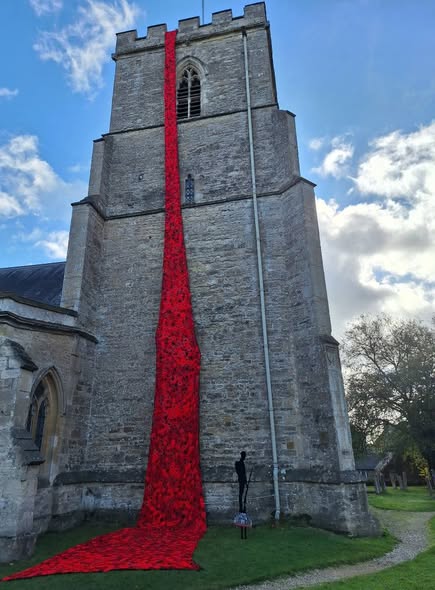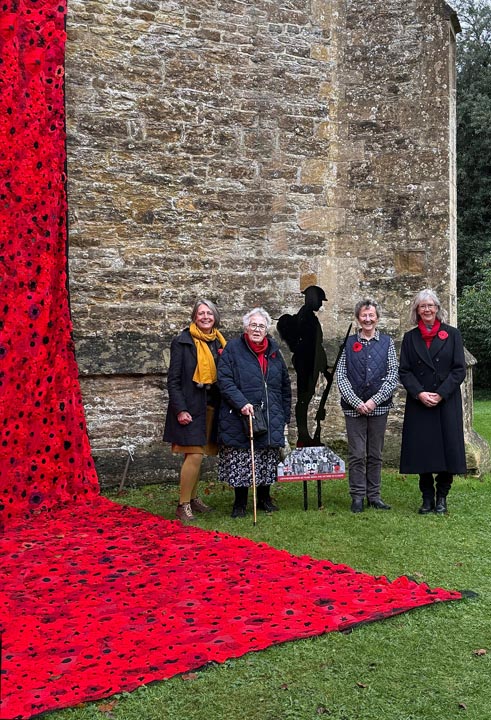Poppy cascade delights villagers and visitors alike

The very many villagers, old and young, who enthusiastically contributed poppies to the cascade project were rewarded with a stunning show of poppies. They didn’t just cascade from the church tower, they covered the church doors and the war memorial too.
Remembrance Day was very special this year as it marked 80 years since the end of the Second World War. To complement the extraordinary show of poppies in the village, Steeple Aston Village Archive (SAVA) held an exhibition called “Steeple Aston in Wartime’. They also put large poppies on lampposts near the homes of many of those who died in the two world wars.
Churchwarden and Poppy Committee member, Eileen Baglin-Jones sends a final report on what has been an extraordinary project:
As we had promised, we used every one of the 6,000 poppies, made by so many willing hands and on November 1st, watched by a small audience, Graham Clifton and a team of bell ringers, hauled the completed cascade up to the top of the tower.
Any anxiety we might have had was soon forgotten as in the bright light of morning the poppies glowed and shone out vibrantly as they cascaded down the North side of the tower at last for all to see. Once the poppy curtain for the South Door and the cross on the small door to the Chancel , which heralded the cascade as you drove up Paines Hill were in place , we breathed sighs of relief and hoped those who had worked so hard to complete the project and anyone from the village or visiting would be pleased with the result.
We have not been disappointed. The idea of creating a memorial to mark the 80th anniversary of the ending of the second World War became a special community project alongside the decorations in the church and the excellent SAVA exhibition.
We have heard nothing but warm appreciation of the effort which has gone into making and now displaying so many poppies. Reports in the press, on the BBC news channel and the response to publicity on social media has brought many visitors. The village was very busy especially during Remembrance weekend and it is a delight that people have been so positive and appreciative of the results of so much work by so many people.
We hope that everyone who has contributed in any way feels at least a small glow of satisfaction. It has been a marvellous village affair!
As a self-selected Poppy Committee we couldn’t be more grateful for the cheerful support so many people have given. It would be invidious to name anyone but you know who you are and we hope you were able to come for coffee after the Act of Remembrance on 11th November to share in the thanks at the completion of this special village creation.

Thanks to the Poppy Committee (l to r) Kay Francis, Eileen Baglin-Jones, Merrill Bayley and Hildy Franken
To see lots more photos of the poppies and Remembrance events, go to the photogallery
Click on the first photo to enlarge, and then navigate using the arrows.
Many thanks to all those who contributed photos.
OCC transport plan now under consultation criticised
Oxfordshire County Council is consulting residents about its Movement and Place Plan for Bicester and Mid Cherwell. They say the plan aims to make public spaces better for the community and upgrade travel routes and infrastructure. You are asked to fill in a survey by Monday, 1st December.
However, Steeple Aston’s Martin Lipson who is chair of the Mid-Cherwell Neighbourhood Plan group says, “Unfortunately this document fails to address many transport issues in our area, despite promises that it would do so. Although the massive project for Heyford Park is mentioned, its impact on traffic in our area is not covered. The Strategic Railfreight Interchange at Ardley, Puy Du Fou and warehousing schemes are not even mentioned.”
Changes to the plan were made following a round table discussion of parish councils where concerns were expressed about the number and scale of developments currently proposed and their impact on the Mid-Cherwell area. Oxfordshire County Council said it would produce a ‘Movement and Place Plan’ to include Mid-Cherwell. They said it would hopefully be used to guide investment and decision-making in the area to ensure that all this development can function effectively.
County Councillor Gareth Epps urges villagers to complete the survey despite its shortcomings He says that the authors (who have added the area in response to the vast amount of speculative development proposed) are working in double quick time and need evidence and submissions to revise this Plan and make sure it’s fit for purpose.
Once the consultation ends, the survey responses and any other feedback received will be considered. The improved and updated Plan will be presented to the Council’s Cabinet in January for approval.
To find out more and complete the survey, go to the OCC website.
Meet Bryan and Renée as they reopen the Red Lion

The new landlords at the Red Lion are looking forward to meeting their customers and hope to become an important and valued part of the village community. They understand that with all the recent uncertainty, villagers want stability and reliability above all.
Bryan and Renée Walker have a long history of working in the hospitality business; indeed they ran a village pub many years ago – so they know what they’re in for. Plenty of villagers are keen to see them succeed and wish them the best of luck.
Originally from Brisbane in Australia, the couple first came to England as backpackers in 1999. They liked it so much they came back here to work in 2003. Later Bryan moved into hospitality management, spending some time as manager of The Head of the River in Oxford.
They moved to Upper Heyford nearly three years ago with their children Eve, now 15 and 13-year-old Sebastian. The other important member of the family is Lucia, a beautiful Italian Spinone dog, who has already made herself at home in the pub.
After a break away, Renée recently decided she wanted to return to hospitality work. An advert for a manager at the Red Lion first brought her to look at the pub, but then they found the tenancy was available and jumped at the chance to take over.
She says, “It could be a terrific pub for the village, I’m really looking forward to getting to know the locals.”
Renée will be front of house with Bryan mainly in the kitchen. He will be helped by a chef de partie. They also hoped to employ another full-time staff member for front of house, as well as several part-timers. She says they like to be hands-on with staff, offering lots of training and career development.
The plan is to offer good simple food, cooked well but not ‘overworked’. Bryan says he is interested in the history and tradition of British cookery. He promises no ‘jus’ but proper gravy! The menu will offer traditional pub food – stews, pies, fish and chips and steak. They will be largely using local produce, with their meat coming from Hook Norton Butchers.
There is also a possibility that they will offer tea, coffee and cake. But for the time being there won’t be any takeaway – maybe that will come later if there’s a demand for it.
Renée and Bryan are going to take their time to get to know their customers and what they’d like from their pub, so they’re not making many immediate changes. Monday poker night will continue, and the quiz already booked for Wednesday, 12th November will go ahead at 8.00pm.
Bryan says he’s a big fan of wine, so may offer wine-tasting or wine and cheese evenings as well as other events in future.
The Red Lion website has details of opening hours and menus. See https://theredlionsteepleaston.com/
Times letter turns Rousham’s Heyford protest national

Many influential friends of nearby Rousham, including TV gardeners Monty Don and Alan Titchmarsh, have expressed horror at the plan for a major new town at Heyford Park only two miles away from the famous gardens. Now, there is a national campaign against the development as well as the local one which has been under way for some time.
Monty and Alan headed a list of influential figures from the worlds of gardening and the arts whose letter was published in The Times on Tuesday, 11th November. There was also a half page article in the newspaper.
The letter said the 9,000 home project would be visible from “important vantage points” within the historic gardens of Rousham House, which was designed in the early 18th century by William Kent, the architect and landscape designer whose work transformed the English garden.
Plans to upgrade Heyford railway station would bring “inevitable traffic” and have a “disastrous impact” on the surrounding area, including the grade II listed medieval bridge providing access to the station, they said.
The planning application fails to address this threat in any meaningful way,” they added. “At the scale proposed, the development risks causing significant and irreparable damage to one of the greatest gardens in the world.”
They urge Cherwell District Council, Historic England and the government to place robust constraints on the scheme to ensure that the setting of this national treasure is protected.
One of the other signatories of The Times letter is Liz Nicholson,Managing Director of Nicholsons, the North Aston nursery. On the Friends of Rousham website she says, “While I accept the imperative need for increased housing in the UK, I would urge us to design mindfully around irreplaceable historic assets like Rousham. If we disregard these beautiful places, we will lose our Genus loci…. and diminish the beauty that makes living in Oxfordshire so special. Please can we take care?”
Another local protester is Charlotte Harris who lives at Cuttle Mill. which is part of Steeple Aston but also part of William Kent’s famous vista from Rousham. She has had a letter published in The Field magazine (complete with photos by our own Nigel Francis). There was also a lengthy article in Country Life.
A leaflet from Charlotte and others is being distributed locally. They say they oppose the scheme on a number of grounds:
- Traffic and infrastructure
- Destruction of villages and countryside
- Environmental harm
- Unsustainable resources
- It’s a developer-led scheme, not community led.
Read the leaflet SAVE OUR COUNTRYSIDE: SAY NO TO A NEW TOWN AT HEYFORD PARK
The plan for this major development at Heyford Park by Dorchester Living is currently under consideration by Cherwell District Council. The site is also on the list of 12 possible New Towns published by government advisors in September. The current plan is for 9,000 houses, but an official New Town would be even larger.
Details of the planning application from Dorchester Living can be found on Cherwell District Council website https://planningregister.cherwell.gov.uk/Planning/Display/25/02190/HYBRID
There have been several hundred objections by local residents and many from other parts of the country and abroad. The Mid-Cherwell Neighbourhood Plan has also objected pointing out that the current Cherwell Local Plan proposes restrictions on further development at Heyford Park.
Although the deadline for comments has passed, you can still object by email to planning@cherwell-dc.gov.uk quoting 25/02190/HYBRID and including your name and address.
You can read more about the proposals and local objections to them in this website’s September archive
Greg joins Graham in aid drive to Ukraine
 Greg Elphick has volunteered to join Graham Porcas in his drive to deliver a rescue vehicle and much needed supplies for wounded soldiers in Ukraine. Both are appealing for your help to raise the necessary funds.
Greg Elphick has volunteered to join Graham Porcas in his drive to deliver a rescue vehicle and much needed supplies for wounded soldiers in Ukraine. Both are appealing for your help to raise the necessary funds.
 Graham is probably best known in the village for driving his steam railway around the field at Robinsons Close at village events. Steeple Aston Parish Councillor Greg’s last big fund-raising trip was on two feet, walking 500 miles on the Camino de Santiago. He says he much prefers the prospect of a nice drive across Europe, even in December. He and Graham make a good combination according to Greg, “A retired engineer and a retired police officer. One to fix the vehicle if/when it breaks down and one to deal with any chaos we cause!”
Graham is probably best known in the village for driving his steam railway around the field at Robinsons Close at village events. Steeple Aston Parish Councillor Greg’s last big fund-raising trip was on two feet, walking 500 miles on the Camino de Santiago. He says he much prefers the prospect of a nice drive across Europe, even in December. He and Graham make a good combination according to Greg, “A retired engineer and a retired police officer. One to fix the vehicle if/when it breaks down and one to deal with any chaos we cause!”
Graham explains their plan:
We have volunteered to drive a second-hand 4×4 or ambulance to Lviv, Ukraine in December. Now we need to raise the funding for the organisers Driving Ukraine to procure a suitable vehicle so that it can be used to help support Ukrainian soldiers who are wounded in their struggle with Russia.
We have to raise at least £10,000 to buy a suitable truck, prepare it for heavy off road use and equip it for the journey and use in Ukraine. If we can raise enough then we can also equip it with a drone detector which we would very much like to do! This will cover the cost of modifications in Lviv to make it suitable to evacuate casualties from behind the front lines. The vehicle will also be packed full of medical supplies and other humanitarian aid for Ukraine
Driving Ukraine are a brilliant outfit who have already enabled more than 250 much needed vehicles to be delivered to Lviv in 50 convoys so far. It is run by two local guys who have been organising these trips since 2022 and know the ropes, their organisation is impressive and they arrange everything, provided I can raise the funding.
Have a look at their webpage for more information: https://drivingukraine.org/ (and see the July website story).
So we are asking for help, specifically money although if you have a spare 4 x 4 pickup you would like to donate then that would be a great help!
Here is their fundraising page: https://donorbox.org/grahamukraine
All donations would be very gratefully received, large or small but if you would like to make a larger contribution please contact me first as there are different arrangements to involve GiftAid if appropriate.
All I can offer in return is free rides on my steam railway at the next Steeple Aston village event!
grahamporcas@btconnect.com
Councils fear the impact of ‘unprecedented’ local development plans
A round table meeting of parish councils to discuss plans for several major developments which are bound to impact local villages heard that the scale of the proposals was even greater than expected. And they are all being treated individually so that there is no attempt to assess the overall impact on local traffic and transport.
Many at the meeting accepted that they couldn’t halt at least some of these developments, but they did agree that the Oxfordshire County Council should produce a ‘Movement and Place Plan’ for Bicester West and Mid-Cherwell. This will hopefully be used to guide investment and decision-making in the area to ensure that all this development can function effectively.
Steeple Aston’s Martin Lipson, who is Chair of the Mid-Cherwell Neighbourhood Plan Forum, was at the meeting. Here is his report:
The meeting called by two County Councillors was well-attended by a wide range of representatives of the many local parishes potentially affected by major development, including some from both Steeple and Middle Aston. Cherwell District Councillors and Calum Miller MP also attended, together with one senior officer each from the County and the District.
The number and scale of the projects was described as unprecedented and includes the following: two large warehouse schemes at Baynards Green (one approved); Puy du Fou at Bucknell (to be decided); Great Wolf leisure complex at Chesterton (approved but stalled); Heyford Park ‘New Town’ including its southwards extension (to be decided); Oxfordshire Strategic Railfreight Interchange near Ardley, currently under consultation (to be decided by Ministers), and a new one – Richborough Estates housing near Caulcott. Also mentioned were ‘Himley Village’ close to Middleton Stoney (approved and slowly being built), and the Botley West Solar Farm extending to near Tackley (another Ministerial decision).
Although each of these projects is alarming in its own right, the real concern being addressed by the meeting was the cumulative impact of all of them together on our small patch of treasured countryside. The biggest worries relate to traffic and transport issues and their impact on rural lanes, villages and the public transport system (such as it is), with thousands of new residents, employees, and the services they require, all moving in and out of the area each day. The loss of countryside, farming land and the impact on the natural environment, air quality and so forth, were also aspects of concern.
A few of those present saw the need for immediate efforts to persuade the authorities and Government to look at the bigger picture and to refuse permission for some of them. Cherwell, we were told, must play by the rules which only permit the local planning authority to decide each proposal on its own merits, not being allowed to look at the cumulative impact of so many schemes. Even worse, some of the projects are to be decided by Government Ministers, over the heads of Cherwell.
Most of the parishes, however, seemed to be focussed on the measures needed to mitigate the developments, perhaps grimly assuming an inevitable outcome of approvals for most or all of the schemes. Revamping Junction 10 on the M40, traffic-calming, enforcement of HGV routing agreements, requiring community benefits to be delivered early – they’re all aspects of mitigation, after the stable door has been slammed shut.
What everyone agreed, though, was that something was needed to help decision-makers to look at that bigger picture – to plan effectively. The county councillors have persuaded their officers to produce a local ‘Movement and Place Plan’ for Bicester West and Mid-Cherwell, as part of the County’s strategic transport planning function. This is apparently to be done at pace, with local consultation on it starting next month. It will form a new part of the County Council’s existing Local Transport and Connectivity Plan, adopted in 2022, and will be intended to guide investment and decision-making in the area to ensure that all this development (and the impacts it will generate) can function effectively.
While of course this is much better than not having such a plan, it will probably be too late to have a great deal of effect on the scale or nature of the proposals.
Most politicians seem to accept that more growth is a good thing, and that their role as decision-makers is to react to the market place in a cautiously positive way. Not everyone present would agree with that. The need for these huge projects must be questioned, and a proper balance found with the vision of rural communities for a future, gently invigorated, but not lost to destruction and confusion.
Heyford Park on government’s list of possible new towns
Heyford Park is listed as one of 12 sites to be considered for development as a New Town in a report by the government’s New Towns Taskforce published on 28th September. This would be an even larger development than the one currently under consideration by Cherwell Distric Council.
The report suggests “Redevelopment of the former airbase at Heyford Park, Cherwell; connecting to Oxford and building on the existing progress and commitment to high-quality placemaking; referencing the area’s past and supporting its future in innovative clean technology industries.” It says that 13,000 new homes could be built on the 505-hectare brownfield site.
The government has said it will begin building in at least three New Towns in this Parliament and is prepared to progress work on a far larger range of locations if it proves possible. It is expected that ministers will make a decision in the Spring on which of the 12 sites will become New Towns.
Oxfordshire County Councillor Gareth Epps commented on the announcement: “While this isn’t a total surprise, it has profound implications for the existing Heyford Park community and the surrounding Cherwell Valley villages.
Any community engagement will highlight concerns about existing commitments which the developers Dorchester are seen to have failed to deliver, on active travel and HGV access to take car transporters away from roads near residents and schools. It will also highlight concerns about an “infrastructure last” approach under previous Tory administrations which have hampered placeshaping.
An essential part of any plans going forward is a reopened Ardley station, a local railhead to reduce the need to travel by car, as well as a rapid bus service to Oxford.”
Dorchester Living, the Upper Heyford developer, has already lodged a planning application with Cherwell District Council for a substantial town of 9,000 new homes on the site. This application would have to be enlarged and tweaked to meet the criteria to be designated a new town.
But the developers say in their application that 30 per cent of the new homes will be affordable; there will also be 900 assisted living units and 180 homes for key workers. There will be five new schools, community facilities, employment space and extensive green infrastructure. Perhaps ironically, there is also a plan for a new Centre for Peace Studies.
This application is in addition to the 1,200 homes already at Heyford Park along with Heyford Free School, a supermarket, a pharmacy, and a hotel.
Martin Lipson, who is Chair of the Mid-Cherwell Neighbourhood Plan Forum has spoken out against the plan. Martin, who is also vice chair of Steeple Aston Parish Council, outlined his objections to the plan in an interview on BBC Radio Oxford. He said Cherwell District Council already has a Local Plan which will deliver thousands of new homes near Bicester and Oxford. Local people did not want such a development built in the countryside.
“A small-ish development at Heyford Park has been acceptable for years” he said, “but the scale of ambition here is just really over the top”.
“Of course we need new homes, especially affordable ones, but this isn’t the right place for such a large development.”
Martin thought local people were sceptical that the infrastructure required for such a large development would be provided. He cited as an example the continued failure to build the promised health centre at Heyford Park.
Dorchester has extensive plans for infrastructure in their application. They also say improved connectivity and sustainable travel will underpin the settlement’s continued growth. They have been working with GWR to facilitate upgrades to Heyford Station and improvements to the Cherwell Valley Line service providing connections between Banbury and Didcot. There will also be enhanced bus routes and walking and cycling routes.
They say that sustainability is at the heart of their plan, with around 60 per cent of the site dedicated to open space – connecting nature corridors, public parkland, walking trails, a boating lake, waterways, and an area set aside as a retained Local Wildlife Site. The old runway will be the centre of a new park which will offer a wide range of leisure opportunities and include the planting of 65,000 trees.
The long-term ambition is for Heyford Park to become the UK’s first renewable energy surplus town, generating more renewable energy than it consumes through a combination of solar and wind power generation, energy-efficient design and low-carbon transport.
If the application is approved by Cherwell District Council, work could start on the development in 2026.
You can see the planning application on Cherwell’s website here https://planningregister.cherwell.gov.uk/Planning/Display/25/02190/HYBRID
There’s more about Dorchester’s plans at www.heyfordparknewtown.com/
You can hear Martin’s interview on BBC Radio Oxford along with contributions from the developer and local MP Liberal Democrat Calum Millar here
See page 40 for the Heyford Park section in the New Towns Taskforce report.
Oxford congestion charge starts
Oxford’s temporary congestion charge scheme started on Wednesday, 29th October. Drivers of cars and motorhomes will be charged £5 a day to go through six congestion charge areas. This is a temporary measure to reduce congestion while Botley Road is closed.
Oxfordshire residents can apply for a permit which allows for 25 days of free travel a year through all six of the congestion charge areas.
The congestion charge areas are:
| Hythe Bridge Street | Monday to Sunday | 7am – 7pm |
| St Cross Road | Monday to Sunday | 7am – 7pm |
| St Clements Street | Monday to Sunday | 7am – 7pm |
| Thames Street | Monday to Sunday | 7am – 7pm |
| Marston Ferry Road | Monday to Saturday | 7am – 9am and 3pm – 6pm |
| Hollow Way | Monday to Saturday | 7am – 9am and 3pm – 6pm |
This means that if you don’t have a permit, you will have to pay the congestion charge to access these car parks:
- Westgate
- Oxford Rail Station
- Oxpens
- Worcester Street
For more details and to apply for a permit go to the Oxfordshire County Council website.
